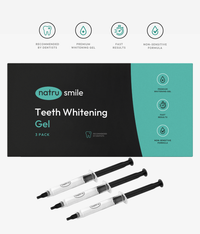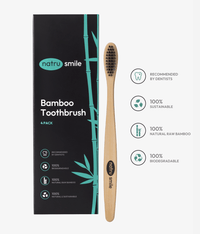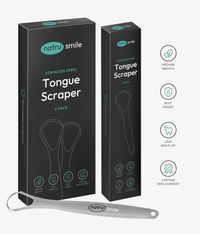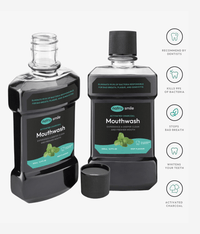
All products are certified by dental expert Dr. Greg Grillo
The thought of getting a dental implant can be unnerving. We know.
The process takes several months, requires one or multiple surgeries, and is often painful and uncomfortable. And because of the work involved, it's also expensive.
For many, it is a dreadful process that is worth avoiding at all costs.
The good news is this: If you're procrastinating on a dental implant, you may be able to get a dental bridge instead. A dental bridge is an alternative tooth replacement option that involves the use of one or more artificial teeth placed between two healthy teeth on either side.
In this article, we'll tell you everything you need to know about dental bridges to help you decide whether it's the right tooth replacement option for you.
What Are Dental Bridges? A Quick Overview
Dental bridges are artificial teeth that are fixed in place between two healthy teeth on either side. They look like regular teeth and are made of either porcelain, metal, or a combination of both.
The bridge consists of an artificial tooth—also called a pontic—and two crowns (or abutments) on either side. The abutments anchor the pontic to the adjacent teeth and hold it firmly in place.
Why Would You Need A Dental Bridge?
There are several reasons you might need a dental bridge, and they all revolve around the need to replace one or more of your teeth.
- To replace a missing tooth (or teeth) without the pain or cost of an implant
- To restore your bite and improve the functioning of your mouth
- Issues with chewing, biting, or speaking clearly due to missing teeth
- Jaw structure and alignment will benefit from a dental bridge
- To stop adjacent teeth from shifting out of their correct positions
- Inadequate bone or gum tissue to support a dental implant
- The appearance of your teeth is affecting your confidence
- Cosmetic reasons, including teeth whitening alternatives and facial contouring
In many cases, more than one of these reasons is at play. For example, a bridge might be used to restore the function of your mouth, but that dysfunction may also be cosmetically noticeable and have a negative impact on your confidence. And it could be caused by a missing tooth.
What Does A Dental Bridge Look Like?
How a dental bridge looks depends on where you look at it from.
- Before it is fixed in place: Before it goes into your mouth, it looks like a single artificial tooth with two abutments (or crowns) on either side. It is sometimes connected by metal frames or wings, which are used to fix it in place. Other times, it is one unit with each tooth connected together.
- From the front (looking at you): Once it has been affixed to your mouth, a dental bridge looks just like the rest of your teeth: natural and seamless. The only difference is that you will be able to remove it. Other than that, it will blend in just fine.
- Behind your teeth: From the back, you can see the metal frames that hold it in position. These are visible if you look into your mouth in the mirror, but it is unlikely someone else will look that closely at your mouth (besides your dentist, of course).
Different Types Of Dental Bridges
The type of dental bridge that works best for you will depend on where in your mouth the bridge will be placed, as well as your individual needs.
1. Traditional Fixed Bridge
Traditional dental bridges are the most common type used today. It uses one or more artificial teeth (pontics) that are held in place by two abutments. The abutments anchor the bridge to your natural teeth with cement and hold your bridge tooth firmly in place.
2. Cantilever Dental Bridge
Cantilever bridges differ from traditional bridges in that they only need one abutment to hold the bridge in place. This type of bridge is limited to certain areas of your mouth and can’t be used if there are teeth missing on both sides of the gap.
3. Maryland Dental Bridge
A Maryland dental bridge—also called a resin-bonded or composite bridge—uses a metal or porcelain framework and resin wings that attach the bridge to your existing teeth. The framework is bonded to your natural teeth and supports the pontic.
4. Implant-Supported Bridge
Implant-supported bridges are similar to traditional bridges but require the placement of dental implants. The implant-supported bridge is attached to two or more implants, which act as abutments, and are held in place by screws or a bit of special resin cement.
Dental Bridges: Before And After (images)
Broken tooth covered by dental bridge.
Before, during, and after dental bridge treatment.
How Long Does A Dental Bridge Last?
Most patients can expect their dental bridges to last at least five to seven years. But the longevity of any dental bridge depends on several factors, including:
- Oral hygiene: Maintaining a good oral care routine will help keep your bridge in good condition. Neglecting your oral hygiene can cause the surrounding gum tissue to recede, the tooth enamel underneath to erode, or the underlying bone to weaken, which can all lead to your bridge failing.
- The type of material used: The type of material used plays a major role in the longevity of dental bridges. The best materials for long-lasting bridges are metal alloys such as titanium or cobalt chromium, which can withstand wear and tear and resist corrosion better than other materials. Porcelain is also an excellent choice, as it is both strong and aesthetically pleasing.
- Where the bridge is placed: The placement of your bridge is also important. When a bridge is placed in an area of your mouth that gets more wear and tear (such as the molars), chewing and other normal activities can cause it to wear down.
- Diet: There are plenty of food and drinks that damage your teeth, and many of them can also damage your bridge. Avoiding sugary, acidic foods and drinks will help keep your bridge in good condition.
On a case-by-case basis, there are other factors that may come into play too, such as your lifestyle, genetics, and overall health.
Research also indicates that bruxism, tongue thrusting, and other parafunctional habits are significant causes of premature wear on dental bridges, leading to the need for earlier replacement.
Alternatives To Dental Bridges
If you're looking for another option, there are a few different alternatives to dental bridges. Depending on your individual situation, these alternatives may be better suited for you than a traditional bridge.
1. Dental Implants
Most of the time, people decide between dental implants or bridges.
Dental implants are small titanium posts that are surgically placed in the jawbone and topped with a crown. They act as an artificial tooth root and can support a single crown or multiple crowns, making them an excellent option for replacing one or more missing teeth.
They require invasive surgery, but they are extremely durable and can last a lifetime with proper care.
Most people that need tooth replacement opt for this option as it is more secure and natural-looking than a bridge.
2. Partial Dentures
Partial dentures are removable prosthetic devices that can replace one or several missing teeth. They have a metal framework with an acrylic and plastic base that fits over your existing teeth, and they can be easily removed when needed.
Although they can't provide the same stability and longevity as a dental bridge, they are more affordable and require less invasive procedures, so those looking for the lowest-cost option often consider them.
3. Crowns
If part of your tooth remains, you may be able to have it covered with a dental crown. A crown is a cap that fits over the remaining tooth structure and completely covers it, restoring its shape, size, strength, and appearance.
Crowns can also be used in conjunction with bridges to provide support and stability. But when comparing dental crowns vs. tooth bridges, the latter is usually more reliable.
Common Problems With Dental Bridges
While dental bridges are effective and durable, they can still suffer from a few common issues. If you have dental bridges, you can expect to experience one or more of the following:
1. Discomfort Or Pain
At some point during your procedure or in the following days, you will probably experience some pain or discomfort around the affected area.
As your body adjusts to the new bridge, the pain should subside, as it is mostly caused by the swelling in your gums, the placement of the foreign object, or the pressure of your bite.
2. Ill-Fitting Bridge
Since dental bridges are custom-made to fit your mouth, there is a chance that the bridge may not fit properly. This can cause discomfort and other issues, such as the inability to chew properly or speak clearly.
If the bridge is too tight, you'll feel the pressure when your dentist inserts it into your mouth. And if it is too loose, it will fall out or become dislodged easily.
3. Staining
Your bridge may also become stained over time due to the accumulation of plaque and food particles, as well as from certain medications or habits like smoking or drinking coffee. The same habits that cause black spots on teeth can stain a bridge as well.
A professional cleaning or in-office teeth whitening can help remove some of the stains, but you may need to replace your bridge if it becomes too discolored or starts to lose its luster.
4. Food Stuck Under Your Bridge
Since your bridge goes on top of your gums and covers the area where a tooth used to be, food particles can get stuck underneath it. Especially if your bridge is in the back of your mouth, it can be difficult to get the food out with regular brushing and flossing.
The area of your mouth where your bridge is placed can become infected or decay if food displacement goes unchecked.
To prevent this from happening, you should take extra care when flossing and brushing around your bridge, making sure that all food particles are removed from the area. If possible, use a water flosser to help.
Regular checkups will also help catch any potential problems before they become serious.
5. Shifting Of The Bridge
Shifting of the bridge can occur due to normal wear and tear, bruxism, or if you don't practice good oral hygiene. If this happens, you may need to visit a dentist to have the bridge readjusted.
Over time, it is natural for your teeth, gums, and jawbone to change shape, which can cause the bridge to become misaligned. This is one of the problems that come with any kind of dental procedure, and fixing it is as simple as visiting your dentist and having the bridge adjusted or replaced.
6. Unnatural Look
Dental bridges may not be able to perfectly match the color and shape of your existing teeth, which can give you an unnatural smile. To combat this issue, talk to your dentist about any specific concerns you may have and ask for details on what kind of bridge would best blend in with your other teeth.
7. Tooth Decay
The teeth that anchor a dental bridge are susceptible to decay, as are the teeth around it. Even though your fake teeth are made of materials that can't decay, bacteria and plaque can still accumulate around the bridge. This can cause inflammation of the gums and tooth decay in the surrounding teeth, leading to more oral health problems down the line.
8. Tooth Sensitivity
Once a dental bridge is in place, you may experience increased sensitivity to hot and cold temperatures. This could be due to the pressure exerted on your teeth by the bridge or because of the changes it makes to your bite.
If you had a tooth extraction or tooth canal on the tooth under the bridge, you won't experience any sensitivity in that area, since your tooth will have been sealed off during the procedure. Still, the areas around it may be sensitive due to the bridge.
9. Damaged Bridge
Your bridge is susceptible to cracks, chips, and other damage due to age-related wear or trauma. This shouldn't happen right away—dental bridges usually last several years—but it is important to check your bridge regularly for any signs of damage.
If you notice any cracks or chips, visit your dentist right away and have the bridge repaired or replaced.
10. Cracked Tooth
If you have crowns over the teeth that anchor your bridge in place, they can become cracked underneath the bridge. This can be caused by a bad bite, trauma to the mouth, or regular wear and tear over time.
It can also be caused by an infection or a dead tooth under the anchored crown. This can be the result of unnoticed gum recession behind your dental bridge, which can lead to a cracked or loose crown.
For this reason, it's essential to visit your dentist for check-ups and x-rays to check for any potential issues with your bridge. This will help you catch and treat any problems before they become serious.
How Much Does A Dental Bridge Cost?
How much your dental bridge costs depends on factors like where you live, the kind of bridge you get, and whether or not you have insurance.
On average, a dental bridge can cost anywhere between $500 and $1,500. Maryland bridges can be more expensive than this ($2,300), and implant-supported bridges start at $5,000.
Dental insurance doesn't usually cover cosmetic procedures. But since dental bridges have functional and medical benefits, some insurance companies may cover part of the cost. If you're lucky enough to have this coverage, it can make the procedure more affordable.
Replacing Teeth With A Dental Bridge: Step-By-Step Procedure
Depending on the type of bridge, state of your oral health, placement position and location, and other factors, the procedure for getting a dental bridge will vary.
Most dental bridge procedures will follow this general process:
- Diagnosis and treatment planning. This includes an oral exam, x-rays, and 3D imaging to check the health of your teeth, gums, and jawbone.
- Tooth preparation. The dentist will remove any decay or damaged enamel from the affected teeth, then shave them down to make room for the bridge.
- Making an impression of your teeth. This is done to create a model of your mouth so the custom bridge can be made in the lab.
- Fitting a temporary bridge and/or prescribing antibiotics if needed. The dentist may place a removable bridge until the permanent one is ready, or prescribe antibiotics to prevent infection during the next step.
- Placement of the permanent bridge. The dentist will check the fit and bite, make adjustments as needed, then cement or bond the bridge in place.
- Follow-up visits. After placement, your dentist will want to see you for a few follow-up visits over the next few months to check on how you're doing and make sure everything is in place.
- Regular maintenance. Dental bridges need regular cleaning and care, just like your natural teeth. You'll need to brush twice a day and floss daily, as well as visit your dentist for regular check-ups and cleanings.
Final Thoughts
A dental bridge is an excellent option for tooth replacement if you're looking for a more cost-effective or less invasive alternative to an implant. Still, knowing the risks and ensuring you're taking good care of your bridge goes a long way.
To make sure your bridge lasts, be sure to visit your dentist for regular check-ups and cleanings. This can help catch any issues with the bridge before they become serious and costly.
If you have any questions about dental bridges or if you're considering getting one, talk to your dentist—they can answer all of your questions and provide feedback based on your individual situation.
Want to learn more? These are the questions our customers ask us the most.
How Do You Clean A Dental Bridge?
You should brush and floss your bridge just like you would with your natural teeth. A water flosser can also be used to help clean the bridge and get rid of food particles that are stuck in between the teeth. You should also visit your dentist for bi-annual check-ups and professional cleanings.
How Long Does It Take To Get A Dental Bridge?
From first consultation to finished bridge, it generally takes about one month.
The process requires a minimum of two appointments, and the actual bridge has a lead time of two to three weeks. If you and your dentist have scheduling issues (e.g., difficulty taking off work on your end or a fully-booked calendar on theirs), this process may take up to two months.
How Do You Care For A Permanent Dental Bridge?
You would care for a permanent dental bridge in the same way you would care for your natural teeth: by brushing and flossing twice a day, using fluoride toothpaste, and avoiding harmful habits like smoking. The only difference with a bridge would be the extra care required for the false tooth, as it is not as easily accessible as natural teeth. Your dentist can give you specific instructions on how to care for your bridge properly.
Does A Dental Bridge Feel Natural?
At first, you may feel pressure while biting or a feeling of heaviness in your mouth, but these symptoms will go away after a few days as you get used to the bridge. You can also expect some minor differences in terms of how your teeth feel when eating or speaking. Even if the differences in your tooth shape are fractions of a millimeter, you may initially notice them in your bite. Within a few days, you will adjust to these slight differences.
How Many Teeth Can You Have On A Bridge?
Dental bridges can have up to four teeth, but generally, they only replace one or two. Any more than four teeth would require a partial denture, implants, or a different tooth replacement option. This is because bridges are designed to fill the gap between teeth, so more than four teeth would create too much weight on the bridge.
Who Is Not A Good Candidate For A Dental Bridge?
People who suffer from tooth decay, gum disease, or other underlying condition in the area where a bridge would be placed may not be an ideal candidate for a dental bridge. This is because bridges rely on surrounding teeth for support and stability, so any existing issues could cause complications.
Do Dental Bridges Fall Out Easily?
Dental bridges are securely bonded to the anchor teeth, so they don't fall out easily. However, with improper care or if your dentist doesn't place a bridge correctly, it could come loose over time.
Can Food Get Under A Dental Bridge?
Food can definitely get stuck under a bridge, but it's usually just as easy to clean as natural teeth. You can use a water flosser or a toothpick to remove the food particles, just be sure not to damage the bridge in the process.
Are Dental Bridges Worth It?
Like any oral procedure, almost everyone who gets a bridge loves their results.
The bridge is a permanent solution to missing teeth, and it looks and functions just like natural teeth. Despite the high costs of dental work, bridges are an excellent solution for replacing missing teeth.
What Type Of Dental Bridge Is Best?
Traditional fixed bridges are typically the best option for filling gaps in your smile as they provide a sound foundation of strength, thanks to abutment teeth on either side. Unfortunately, when there is no space available to attach the bridge on one end of an opening, cantilever bridges may be necessary instead.
Can A Dental Bridge Last 30 Years?
It is unlikely that a dental bridge will last 30 years, as the average lifespan of a bridge is five to 15 years. However, with proper care and regular dental check-ups, you can extend the life of your bridge significantly.
Can Teeth Decay Under A Bridge?
Yes, teeth under a bridge can develop decay if they are natural teeth. It is important to brush and floss twice daily to help reduce the risk of decay, and visit your dentist every six months for a dental check-up. Your dentist may also recommend additional treatments such as fluoride varnishes or sealants to protect against cavities.
Why Is A Bridge Better Than A Denture?
Most people prefer bridges to dentures because they are more secure and permanent. Bridges are also much easier to clean, as they can be brushed and flossed just like natural teeth. Dentures may require more maintenance, such as soaking in a cleaning solution or having them adjusted to fit properly. They also need to be removed at night, which can be inconvenient.
What Foods To Avoid With A Bridge?
Foods to avoid with a dental bridge include sticky and hard foods such as caramels, candy, gummy bears, nuts, pretzels, and ice. Avoid opening packages with your teeth or using them to pry open bottles or cans as well. Chewing on hard objects like pens or pencils can also cause the bridge to break or come loose.
Can I Brush My Teeth After A Dental Bridge?
You can brush your teeth as normal after a dental bridge is placed. Be sure to brush gently and use a soft-bristled toothbrush and fluoride toothpaste, or you can use an electric toothbrush for extra cleaning power. Flossing should also be a daily habit to remove food particles and plaque from underneath the bridge.
Can A Bridge Be Attached To Only One Tooth?
A bridge can be attached to only one tooth. This is called a cantilever bridge and is used when there isn't enough space or support on either side of the gap to attach a regular bridge. Unfortunately, this type of bridge can be more prone to damage as it relies on a single tooth for support.
How Does A Dental Bridge Stay In Your Mouth?
Dental bridges stay in your mouth because they are anchored to the teeth on either side of the gap. These abutment teeth provide the bridge with a reliable and sturdy base, while metal clasps or resin cement keep it securely in place.
Can You Chew Gum With A Permanent Bridge?
Like most other activities, you can chew gum with a permanent bridge. However, limiting sugary gum is recommended as it can adhere to the bridge and damage it in the process. It is also important to use caution when chewing hard or sticky foods, such as caramels or gummy bears, which can pull at the bridge and eventually cause it to come loose.
Can You Put A Dental Bridge Over The Front Teeth?
Dental bridges are able to be placed over the front—or anterior—teeth. In fact, these teeth are usually more secure because they are rarely used for chewing and are held in place more firmly by the surrounding teeth. However, they are also more visible, making it important to have a bridge that matches the size and shape of your teeth.
Is A Dental Bridge Permanent?
Dental bridges are one of the most permanent options, lasting a minimum of five to seven years. For a longer-lasting option, people can opt for a porcelain-fused metal bridge, which typically lasts 10 to 15 years. Dental implants are the most permanent option and can last a lifetime with proper care.
Are Tooth Bridges Strong?
Tooth bridges are typically strong and designed to withstand the forces of biting and chewing. They are made from metal or ceramic fused with porcelain, which makes them highly durable and able to withstand significant pressure before breaking. Taking care of your bridge is also important for longevity—proper care can ensure long-term strength.
Are Bridges More Comfortable Than Dentures?
One reason many people prefer bridges over dentures is due to their comfort and fit. A bridge is designed to fit the contours of your mouth, meaning that it molds seamlessly and comfortably with your teeth. Unlike dentures, bridges don't need to be removed or adjusted as often and can last for many years with proper care.
What Is The Best Toothpaste For Bridges?
You can use any toothpaste for your teeth once you have a bridge. If you suffer from sensitivity as a result of your bridge, a toothpaste specially made to minimize sensitivity can help. Look for toothpaste with added desensitizing agents such as potassium nitrate, strontium chloride, or fluoride.
Can You Sleep With A Dental Bridge?
Since dental bridges can't be taken out, you can sleep with them in. However, it is important to take special care when sleeping with a bridge as certain positions—such as sleeping on your stomach or side—can put extra pressure on the bridge and cause it to come loose or break.
Can You Feel A Bridge In Your Mouth?
At first, the feeling of your new bridge will be noticeable as it is not a natural part of your mouth. But with time and proper care, the bridge will become less noticeable and more comfortable until you can barely feel it. Most people report that they quickly forget they have a bridge once it has been in their mouth for some time.
Will Gums Grow Around A Bridge?
Receding gums cannot grow back, even if a damaged or decaying tooth is removed and replaced with a bridge. However, the gums around the abutment teeth may grow over time, especially if they are not cleaned properly or if there is an accumulation of plaque or tartar in that area. It is important to keep your mouth healthy by brushing twice a day and flossing daily.
Is A Bridge Better Than A Crown?
Whether you opt for a bridge or a crown depends on the situation. A bridge is best when replacing one or more missing teeth, while a crown works best recommended if a single tooth needs to be restored.
Can You Use An Electric Toothbrush With A Bridge?
Electric toothbrushes are more effective than regular ones at removing plaque and are just as safe to use for bridges. Just make sure you brush gently but thoroughly. Use a specially designed toothbrush head with soft bristles, and be sure to brush every surface of your bridge in order to remove all food particles and bacteria.
Why Does My Dental Bridge Smell Bad?
Since bacteria collects around and beneath the bridge, it is not uncommon for a bridge to develop bad breath or an unpleasant smell. Be sure to brush and floss your bridge twice daily in order to keep your mouth clean and free of bacteria.
Do You Need A Root Canal Before A Bridge?
A root canal treatment must be performed prior to a bridge if the adjacent teeth have become infected or decayed. However, this is not always the case—a bridge can be placed without a root canal if the abutment teeth are healthy. Your dentist will determine if this is an option for you.
Can A Dental Bridge Be Removed?
Although loose bridges can usually be effortlessly taken out and restored, the cement used to bond them generally lasts for years. As such, it may not always be possible to remove a bridge without causing harm to other adjacent teeth's support systems.












